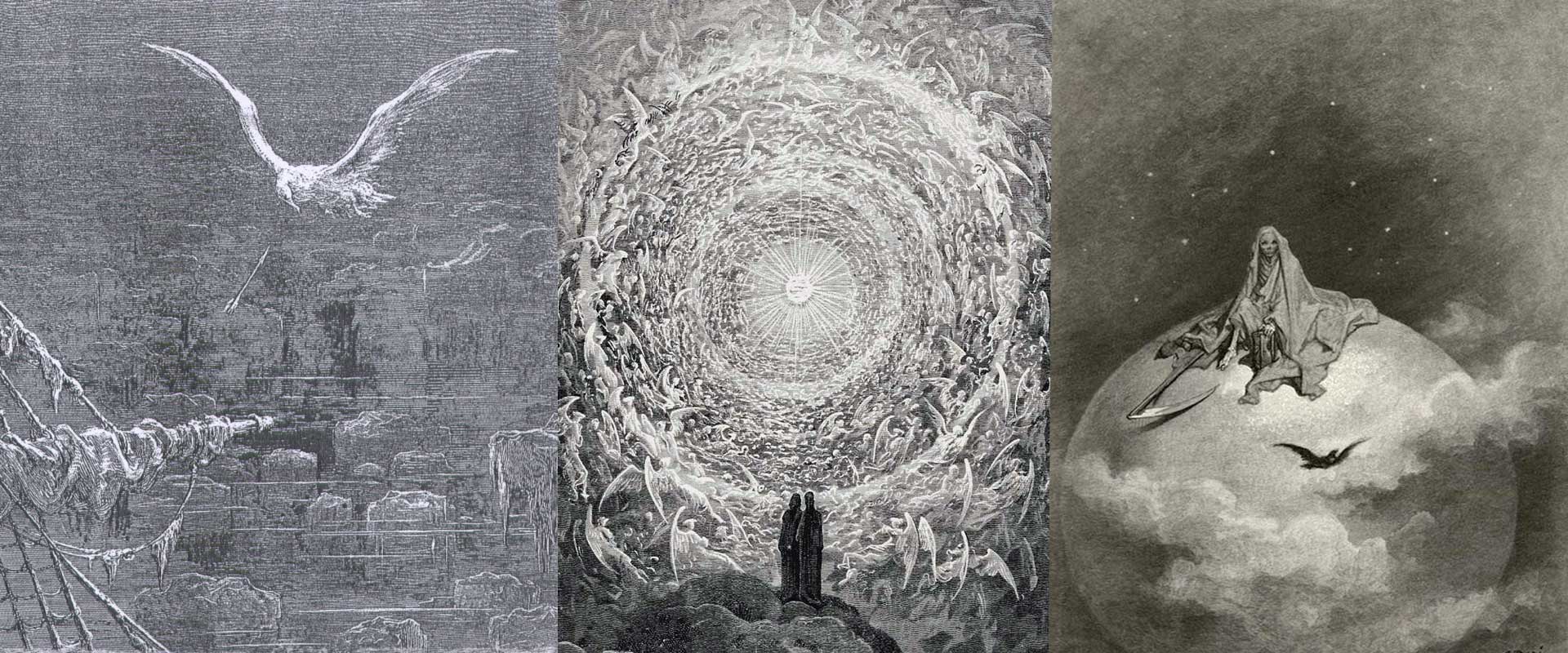Paul Gustave Doré remains one of the most celebrated illustrators in history. His engravings transformed how readers visualized literature, religion, and mythology. Through his unparalleled imagination and technical mastery, Doré turned words into visions, creating images that defined how generations pictured Dante’s Hell, Milton’s Satan, Cervantes’ Don Quixote, and the sacred stories of the Bible.
To explore Paul Gustave Doré’s greatest engravings is to encounter the essence of his genius: dramatic light and shadow, breathtaking scale, and the power to make eternity visible. His art is more than illustration—it is an emotional and spiritual journey etched into the page.
The Divine Comedy – Doré’s Defining Masterpiece
Inferno: The Horrors of Eternal Punishment
Doré’s engravings for Dante’s Inferno (1861) are among his most iconic. With writhing sinners, storm-driven souls, and monstrous demons, Doré captured the terror of eternal punishment. His vision of Hell has become so influential that many cannot imagine Dante’s poem without Doré’s engravings.
Purgatorio and Paradiso: From Suffering to Glory
While Inferno remains the most famous, Doré’s engravings for Purgatorio and Paradiso show his versatility. In Purgatorio, he illustrated repentance, hardship, and the slow climb toward salvation. In Paradiso, Heaven becomes a realm of radiant light, with angels and saints arranged in cosmic harmony. These works cemented Doré as the definitive visual interpreter of Dante.
Paradise Lost – The Fall of Angels and Humanity
Doré’s illustrations for John Milton’s Paradise Lost (1866) offered another of his monumental contributions to art. Here, Satan is both majestic and tragic, a figure of pride and defiance. The fallen angels, the great battles of Heaven, and the sorrow of Adam and Eve are presented with epic grandeur.
Doré’s vision of Paradise Lost shaped how modern culture perceives Satan—not simply grotesque, but proud and doomed, embodying rebellion against God. These engravings remain some of the most reproduced images of Milton’s masterpiece.
The Bible – A Monumental Achievement
Doré’s illustrated Bible (1866) is often considered his magnum opus. With over 200 engravings, it covered the entire sweep of scripture—from Creation to Revelation. His images of the Flood, Moses parting the Red Sea, and the Crucifixion are unforgettable.
The Doré Bible became a cultural phenomenon, influencing how believers worldwide visualized the sacred texts. Even today, its impact endures, much like the way Bible verse wall art prints continue to pair scripture with imagery to inspire faith.
Don Quixote – Bringing Cervantes’ Hero to Life
In 1863, Doré illustrated Miguel de Cervantes’ Don Quixote. His engravings captured both the humor and tragedy of the knight-errant’s adventures. Scenes such as Don Quixote tilting at windmills or riding alongside Sancho Panza became the definitive images of Cervantes’ characters.
These engravings showcased Doré’s ability to balance satire with empathy. Don Quixote is portrayed as both foolish and noble, making him one of literature’s most human figures. Doré’s illustrations remain inseparable from the novel itself.
Other Iconic Works
- Paradise Lost engravings of the battle in Heaven remain unmatched in scale and drama.
- Rime of the Ancient Mariner captured the supernatural eeriness of Coleridge’s poem.
- Jerusalem Delivered (Torquato Tasso) reflected Doré’s love of epic storytelling.
- The Raven (Edgar Allan Poe) illustrated the haunting tone of Poe’s masterpiece.
Doré’s versatility meant that whether illustrating sacred scripture or gothic poetry, he brought the same intensity of vision.
Doré’s Iconic Engravings at a Glance
| Work Illustrated | Year | Key Themes | Impact on Culture |
|---|---|---|---|
| The Divine Comedy | 1861–1868 | Hell, Purgatory, Heaven | Defined global imagery of Dante’s afterlife |
| Paradise Lost | 1866 | Satan’s rebellion, Fall of Man | Shaped modern perception of Satan |
| The Bible | 1866 | Creation to Revelation | Most influential illustrated Bible of the 19th c. |
| Don Quixote | 1863 | Satire, heroism, tragedy | Cemented Quixote’s image in culture |
| Rime of the Ancient Mariner | 1870 | Guilt, fate, the supernatural | Visualized the eerie tone of Coleridge’s poetry |
Doré’s Lasting Legacy
Doré’s engravings influenced not only literature but also modern art, cinema, and popular culture. His Hellscapes inspired Gothic films and fantasy art. His heroic and tragic figures shaped how illustrators approached epic storytelling. Even now, Paul Gustave Doré’s dramatic Bible illustrations continue to be studied and admired.
Doré’s ability to blend grandeur with humanity ensured that his engravings were not just decoration, but powerful works of art that endure through generations.
Conclusion
Paul Gustave Doré’s greatest engravings stand as monuments to human imagination and faith. From the despair of Inferno to the radiance of Paradiso, from Milton’s rebellious Satan to the humble nobility of Don Quixote, Doré gave us images that continue to shape cultural imagination. His engravings remind us that illustration can be more than art—it can be an eternal vision etched in shadow and light.
For modern admirers, curated collections like Paul Gustave Doré art prints or spiritual artworks offer ways to bring Doré’s genius into contemporary spaces.
FAQs on Paul Gustave Doré’s Greatest Engravings
What are Paul Gustave Doré’s most famous engravings?
His most famous works include engravings for Dante’s Divine Comedy, Milton’s Paradise Lost, the Bible, and Cervantes’ Don Quixote.
Which engraving best represents Doré’s skill?
Many point to his illustration of Dante and Virgil gazing upon Hell’s vast landscape in Inferno as one of his most masterful compositions.
Why were Doré’s Bible engravings so influential?
They were widely reproduced, making them the most accessible illustrated Bible of the 19th century. They shaped how millions visualized scripture.
Did Doré illustrate works outside of religious texts?
Yes. Doré illustrated secular masterpieces such as Don Quixote, The Rime of the Ancient Mariner, and Poe’s The Raven, proving his versatility.
Where can I find Doré’s engravings today?
His works are available in museums, libraries, and published collections. High-quality reproductions are also available through curated art collections.





